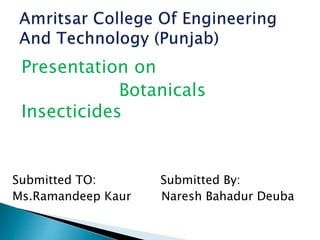
Botanical insecticides
- 1. Presentation on Botanicals Insecticides Submitted TO: Submitted By: Ms.Ramandeep Kaur Naresh Bahadur Deuba
- 2. These insecticides are naturally occurring chemicals extracted from seeds, flowers ,leaves,stem and roots, are termed as botanical insecticides.
- 3. Insect toxins derived from certain plants. Quick action on target pests. Broad spectrum action (non-selective). Do not persist in the environment. Factors Affecting Use of Botanical Pesticides: Raw material availability Solvent types, plant species and part of plant Rapid degradation State registration Market opportunities for botanical pesticides Weather conditions
- 4. Often these plants also have other uses like household insect or are plants with medicinal applications. Some of these products may be used shortly before harvesting. Many of these products act very quickly inhibiting insect feeding. Since most of these products have a stomach action and are rapidly decomposed they may be more selective to insect pests. Most of these compounds are not phytotoxic.
- 5. Most of these products are not truly pesticides since many are merely insect deterrents and their effect is slow. They are rapidly degraded by UV light so that their residual action is short. They are not necessarily available season long. There are no legal registrations establishing their use. Not all recommendations followed by growers have been scientifically verified.
- 6. The botanical pesticides are divided into two generations: The 1st generation included:- Nicotine, Rotenone, Ryania, Pyrethrum. 2nd generation included:- Synthetic Pyrethroids and Neem Products Potential new Botanicals:- Annonaceous Acetogenins, Sucrose Esters
- 7. Sources :Tobacco plant(Nicotiana tabacum) Extracted from:leaves Action :contact and fumigants action Affect on :aphids thrips and caterpillars Nicotiana tabacum
- 8. NICOTINE SULPHATE :is an insecticide of plant origin. It is very effective against a wide range of insect-pests affecting crops of economic importance as well as on ectoparasites affecting livestock. Mode of Action: NICOTINE SULPHATE acts upon the central nervous system of the insects. It has both contact as well as fumigation action. Uses: NICOTINE SULPHATE 40% is used to kill aphids, bugs, worms, leafhoppers and similar sucking insects which attack and destroy fruit, vegetables, crops and even flowers. It is also effective against Lice, Mites and Ticks which are a menace to livestock.
- 10. Derived from: Chrysanthemum cinerariaefolium Caution: Do not mix with soap! Examples:PyGanic (5% EC, OMRI-approved), Ever Green (6% EC) Extracted from: Flower Action:stomach poison Affects on:- Caterpillars,Aphids, Leafhoppers, Spider mites, Bugs, Cabbage worms,Beetles
- 11. Mode of action:- Pyrethrum is a naturally derived,professional-grade pesticide which attacks the nervous system of a wide spectrum of pest insects. Pyrethrum 5EC kills aphids, fruit flies, fungus gnats, greenfly, spider mites, ticks, tobacco beetles, whitefly, blackfly, springtails, moths and many other garden pests. Pyrethrum 5EC is registered as suitable for organic and non-organic farming as it kills pests quickly, leaves no toxic residue and edible food crops can be safely harvested only 24 hours after application. Pyrethrum 5EC is a natural insecticide made from dried Chrysanthemum flowers and it is registered as suitable for both organic and
- 12. Target insects: Aphids, cucumber beetles, caterpillars... Best used against small-sized and immature insects. Short residual – reapply frequently! Add synergist like PBO to increase efficacy.
- 13. Fruit quality with Pyganic (pyrethrum) (Cullman, AL, 2012) Untreated check Pyganic foliar 90% fruit damage 30% fruit damage
- 14. Neem – derived from Persian word Asad-dilakt-I- hind, which means free tree of India - Azadirachta indica A. Juss. In India 14 million trees (1959 survey) of which 50 % in UP. Though not a forest tree it grows wild I the forests of AP, Tamil Nadu and Karnataka. Full-grown neem tree yields 50 kg fruit annually and 350 kg of leaves. India probably produces 0.7 million tones of fruits and 5 million tones of leaves every year.
- 15. Almost every part of the tree is bitter and finds its application in indigenous medicine. Oil and cosmetic industries are the users of neem. The refined and purified neem seed oil has many therapeutic properties. Considerable quantities of oil are used in cosmetic preparations. The neem cake after oil recovery is used for slow release of nitrogenous fertilizers. Neem oil contains limonoids, a class of compounds that act as antifeedants or growth regulators in insects. They do not kill instantly but wipe out a whole generation of insects by preventing the young ones from maturing and the adults from reproducing.
- 16. Neem oil contains limonoids, a class of compounds that act as antifeedants or growth regulators in insects. They do not kill instantly but wipe out a whole generation of insects by preventing the young ones from maturing and the adults from reproducing. It is similar to the insect hormone ecdysone, which is needed for moulting during insect development. It works at a concentration of 1-10 ppm by blocking ecdysone’s action, thereby preventing the larvae from shedding their external skeletons and maturing. It also prevents feeding in about 200 insects at a concentration of 10-100 ppm.
- 17. Source :Neem tress Extracted from :seed (fruit) Action:- Systemic Poision Affects on:- Stem borers, Bollworms, Leaf miners, Caterpillars, Aphids, Whiteflies, Leafhoppers, Mites and Thrips
- 18. Triple Action Neem Oil is the organic way to protect your plants. The neem oil extract is key to protecting your plants from all manner of diseases, like mildew, leaf spot, and blight. These can be a big problem throughout the nation, so make sure to protect all your plants, no matter... Mode of Action:- Neem oil is not a contact poison. It does not kill insect pests directly. It is systemic in action, mainly affecting the feeding as well as growth and development of insects. Nothing will happen immediately even if you spray the oil on them, so people often come to the conclusion that neem oil is ineffective and just all type.
- 20. Neem has systemic properties; reduced lettuce aphids on seedlings (Palumbo et al. 2001). Best against immature insects as foliar spray. Tank-mix & premixes are also effective.
- 21. THANK YOU